Nothing adds elegance and class to interior decoration like an exquisite piece of antique furniture.
But what happens when you have a small or limited indoor space? Certain antiques will take up a lot of room, and including them in your decor may not always be the most practical decision.
Fortunately, plenty of options remain for those who still appreciate the artistry and craftsmanship of fine furniture without having ample space for it.
Today, we dive into the world of antique drop leaf tables. The quick-folding, space-saving staple of the antique world is the perfect addition for people living in apartments or smaller homes where space is at a premium.
We’ll take a brief look at the history of drop leaf tables, the various styles in which the antiques were made, how to identify them, and what to expect in terms of worth and value.
Table of Contents
What is a Drop Leaf Table?
A drop leaf table is made up of a central, non-moving table top along with two folding sections attached at either side with a hinge mechanism.
Some versions of the design include only one folding section, though the classically recognized drop leaf table typically folds on both sides.
These foldable sections can be quickly raised and fixed to stay up, significantly expanding the surface of the table. Alternatively, one (or both) of the sections—each a leaf—can be folded or ‘dropped’ down, reducing the table’s width.
Modern versions of drop leaf tables are also sometimes called ‘butterfly tables’.
Drop leaves are extremely popular—both as antiques and contemporary pieces—because of all the convenient ways they can help save space. They come in many styles and sizes, and are one of the most practical pieces of antique furniture as they can be used in a variety of interior contexts.
The History of Antique Drop Leaf Tables
An earlier iteration of the antique drop leaf was known as the gateleg table. The design was similar, including a stationary central part, connected to two folding flaps which resembled a gate. When opened, these flaps would rest on the table’s own fold-out legs.
Gate-leg tables were first introduced in the 17th century in England and were made primarily from oak, though there are rarer examples of antique gatelegs constructed from walnuts and other fruit-woods.
When folded, the tables would sit flush against a wall, opening up a lot of space in a room. They were incredibly popular and commonly found in homes, cottages, inns, and taverns.
The name ‘drop leaf’ took hold as changes were eventually introduced to the design so the folding sections would no longer have to rest on the table leg, but on brackets underneath the table, which made it much easier to sit at.
Many of the earliest drop leaf tables were made from mahogany, with two of the earliest antique drop leaf designs being the Pembroke and sofa tables.
The Pembroke table functioned more like a dining table with drawers on both ends, while the sofa table was an elongated version, designed to sit at the back of a sofa.
The many versions of modern drop leaf tables available today evolved from these early English designs.
Antique Drop Leaf Table Styles
Contemporary drop leaf tables come in many styles and designs, but antiques typically fall into one of six categories:
Pedestal-base
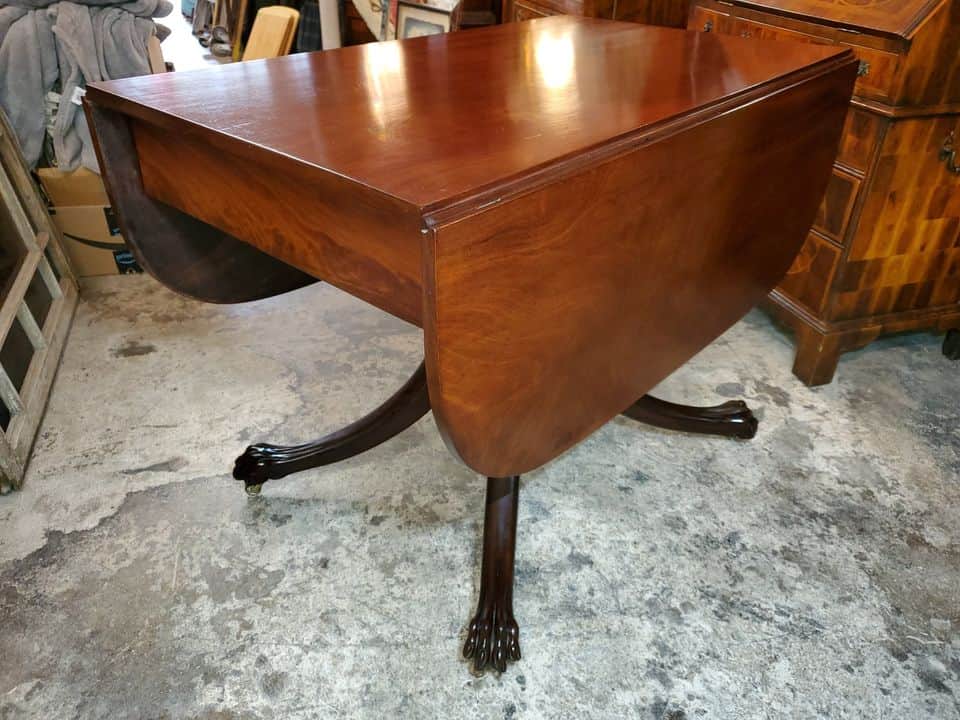
As the name suggests, this table style has a central pedestal base holding up a round drop leaf table. In contrast to traditional table legs, drop leaf tables with pedestal bases take up even less space when folded down, making them incredibly space-efficient.
Gateleg
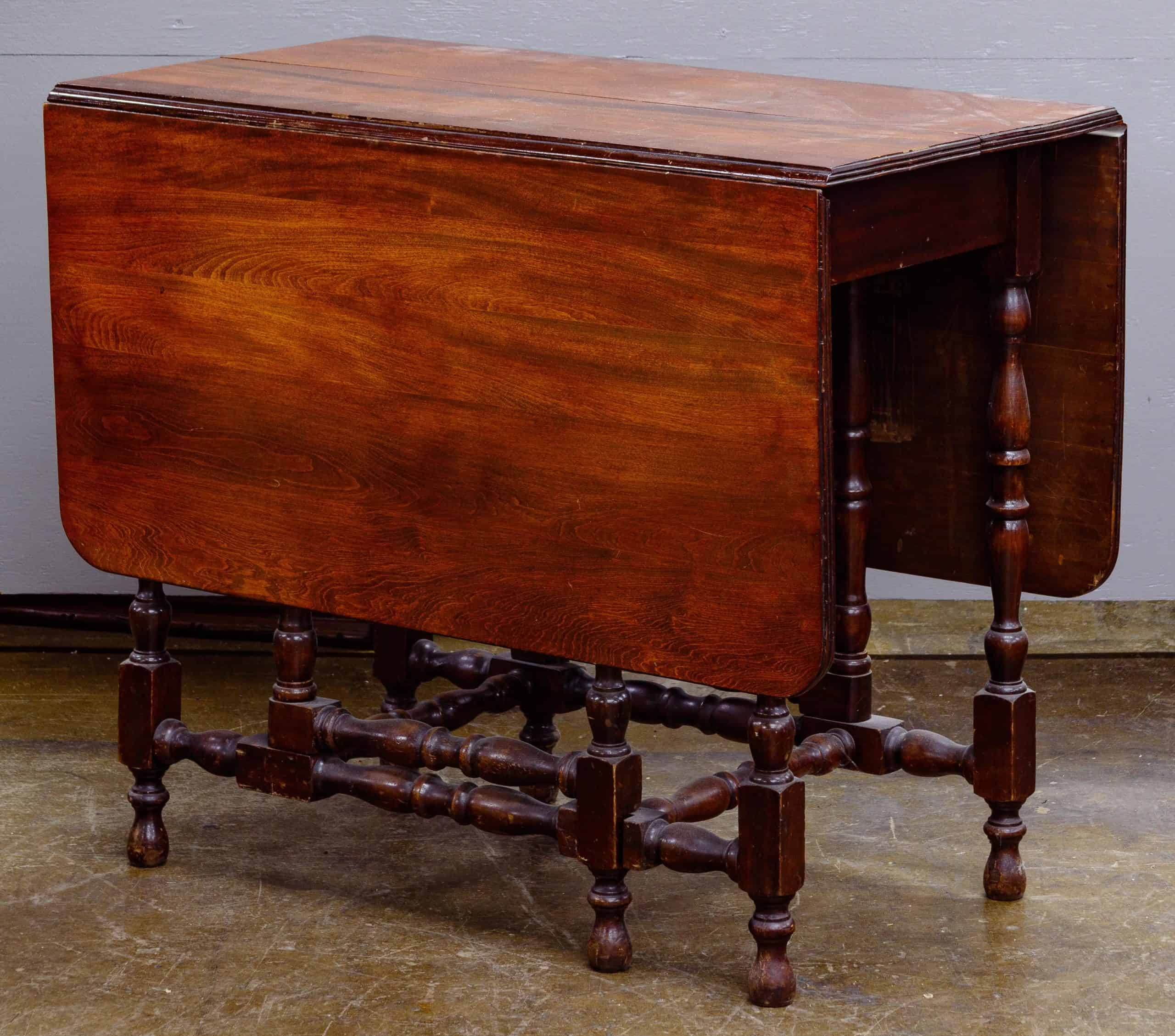
One of the most classical drop leaf table styles is also the oldest. As mentioned earlier, the gate leg was the earliest version of antique drop leaf tables.
Many gateleg tables had Jacobean-style legs, creating a vintage look of classic antique furniture. Gate-leg tables are some of the oldest—and thus most sought after and valuable—antique drop leaf tables.
Side
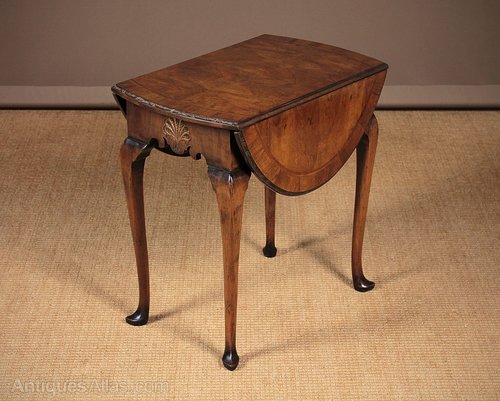
Many antique drop leaves are smaller in size, especially when compared to a typical dining table. These compact drop leaves were designed for general use and proved practical in a number of miscellaneous ways.
Antique drop leaf side tables were made in circular, square, and triangular shapes, and continue to be hugely popular because of their practicality.
It’s not uncommon to see one as the only piece of antique furniture in a modern home.
Coffee
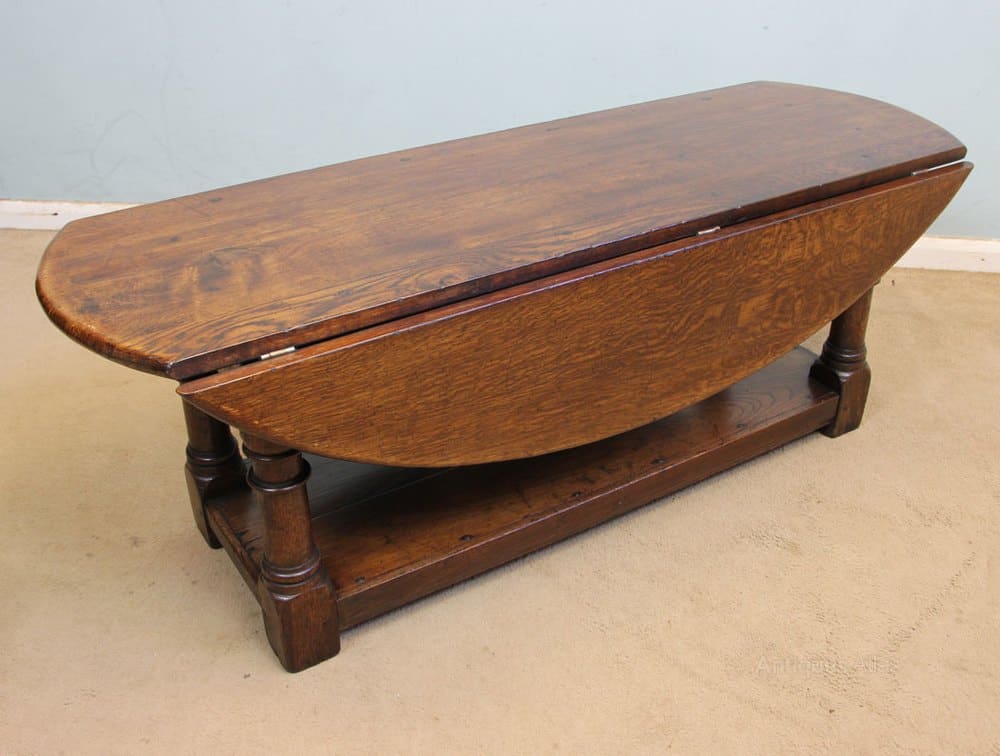
Similar to side tables, antique drop leaf coffee tables are another example of a classical antique style which continues to be popular today.
Typically round or rectangular, antique drop leaf coffee tables stand slightly lower than dining tables, making them ideal for living rooms and studies.
Games
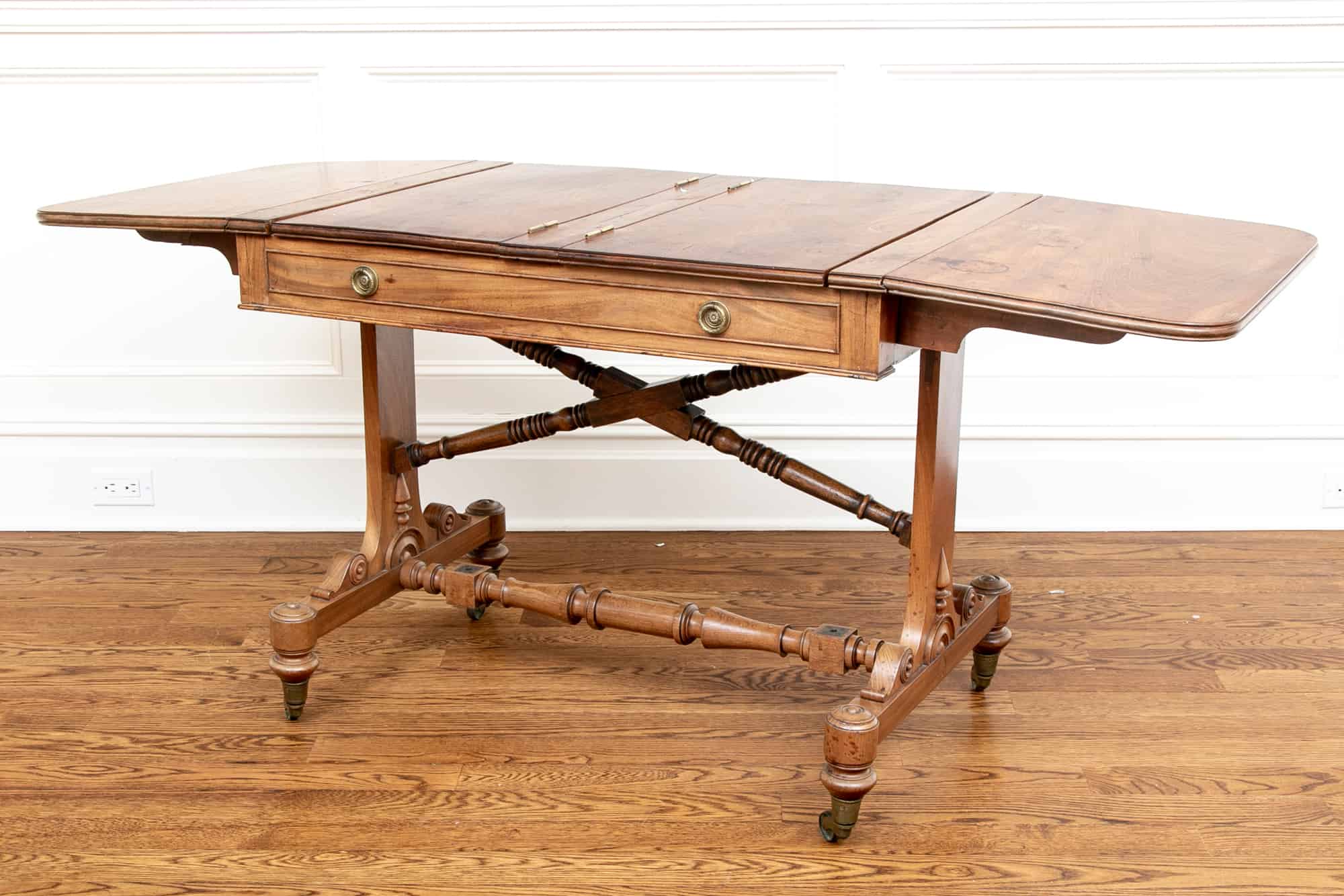
Another antique style is the drop leaf games table. These smaller designs were made specifically to play games on. Usually a chess, checkers, or backgammon board would be carved into the table with small drawers to hold the pieces.
Dining
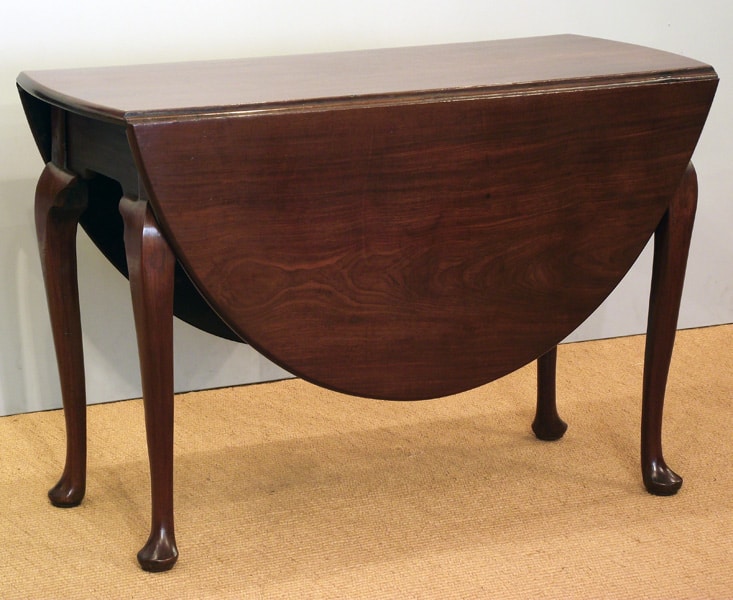
Last but not least is the classical antique drop leaf dining table. Made in both circular and rectangular shapes, the size of these antique tables varies from being able to seat anywhere between two to eight people.
Most contemporary drop leaf tables are a version of these, with many modern tables designed to have the look of an antique.
In the next section, we’ll take a look at how you can differentiate between the two and ensure what you’re looking at is a genuine antique table.
Identifying Antique Drop Leaf Tables
You can determine the authenticity of antique furniture in four principal ways.
As with any antique, remember to examine the piece thoroughly and make sure all four features are present when looking to identify antique drop leaf tables.
Look for the Patina of Time
Any antique is going to be old, and it’s supposed to look old. Even a recently-polished table should have a clear patina of age on its surfaces. This is one of the first and easiest things to pay attention to. A table that looks new or lacks this quality is unlikely to be an antique.
Check the Marks left by the Saw
Prior to the 1800s, the saws used to make tables left a straight mark on the wood. After the early 1800s, improvements in carpentry led to a type of saw being used which left a distinct circular mark. Identifying straight saw marks is another factor indicating a table could be an antique.
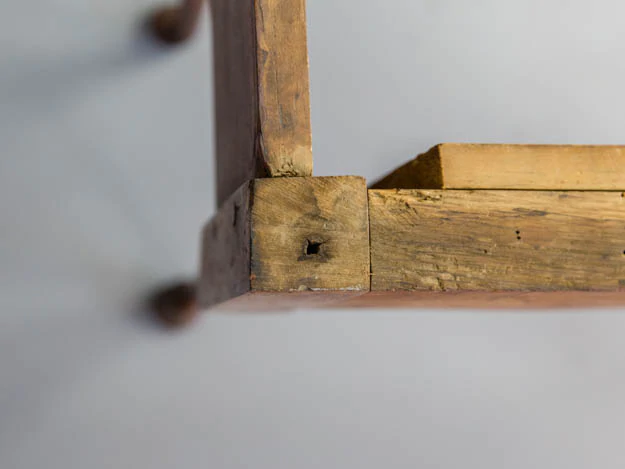
Look for the Materials Used
Examining the materials used to make the piece is another common method for identifying an antique. You can identify a drop leaf table as a genuine piece of antique furniture by looking for the types of screws, nails, and hinges used to make it. Many of these early tools can be easily linked to their time periods, giving you a good idea of when your table was made and whether it could be an antique. For example, square nails or any visible screws that may not be fully centered could indicate an antique piece.
For more details, you can refer to this comprehensive guide on identifying antique furniture hardware.
Check the Stamps & Signatures
Finally, look for any signatures, stamps or other markings used to identify the time period, craftsman, or manufacturer of the table. Furniture markings are instrumental in accurately determining and appraising an antique drop leaf table.
Use this guide on identifying antique furniture marks for a more in-depth understanding of how to spot them.
How Can You Determine Their Value?
As with any antique, the determinant of the value of a drop leaf table is dependent on several factors including size, age, maker, special features, and condition.
Size
While size is certainly not the only determiner of value, it’s still something to take into consideration, especially when looking at antique drop leaves from the same period. Generally speaking, a larger antique drop leaf table in relatively good condition will be valued higher than a smaller piece.
Age
It’s not possible to have a discussion about the value of an antique without considering its age (the time period it was designed and manufactured).
Once again, speaking generally, the older the piece, the more valuable it will be.
As mentioned before, studying the materials and techniques used to create the table can help provide an accurate estimate of the antique’s age.
Maker
Knowing the designer/manufacturer of any antique is the third factor in determining its value. Finding identifying marks (stamps, signatures, marking, etchings) will go a long way in terms of clarifying the value of an antique drop leaf table.
An Ethan Allen or Duncan Phyfe Original are two examples of vintage styles that would be valuable.
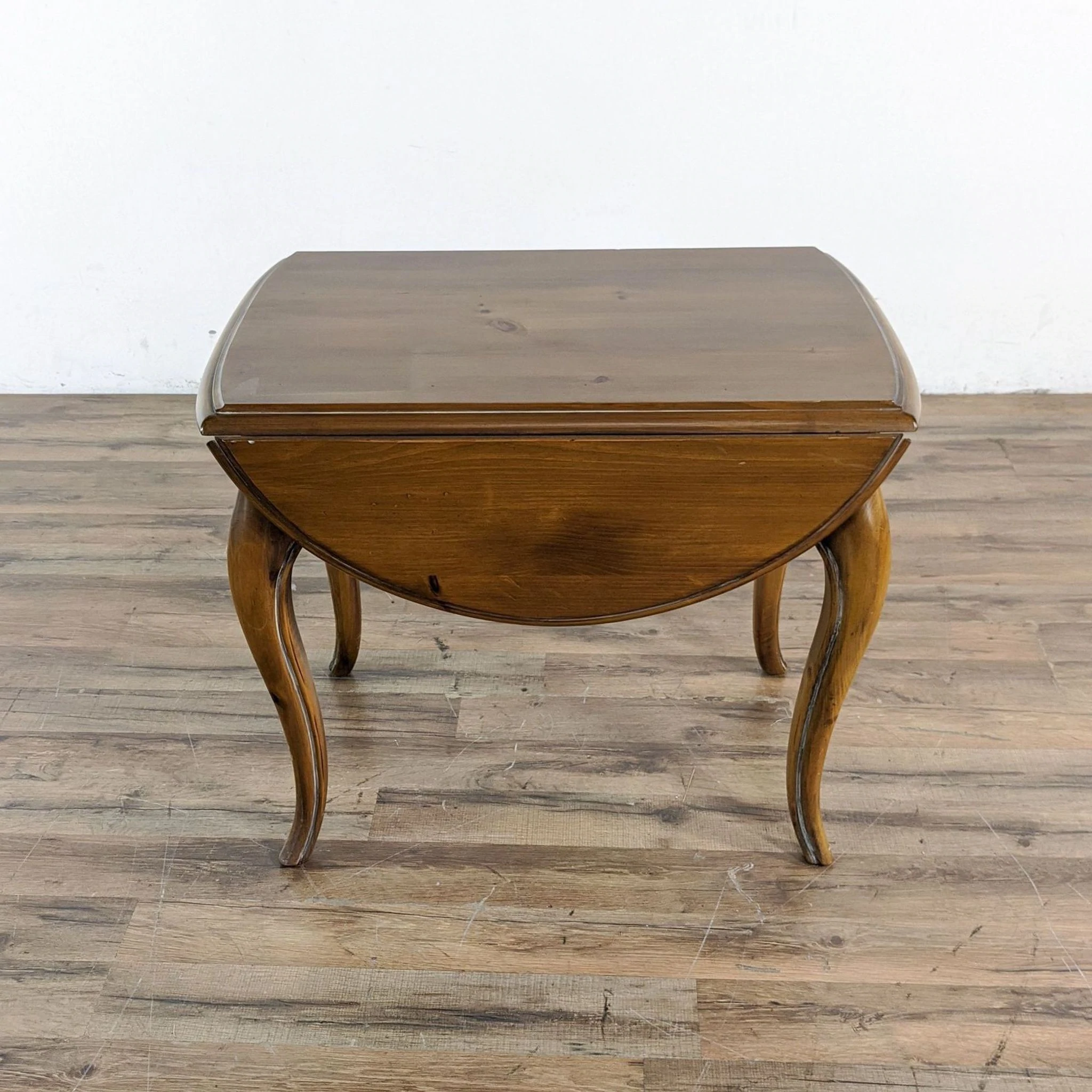
Special Features
Antique drop leaf tables can also have special features which factor into their pricing and overall value.
Some of these could be the use of special and aesthetically pleasing woods like cherry or mahogany. Other features to look for are detailed etchings or hand carvings, and hand-paintings or other decorations.
Finally, some antique tables feature secret compartments, extra drawers, claw or brass feet, and hidden fold up leaves.
No detail is too small for appraising antique value.
Condition
Of course, nothing is more important than the overall condition of your antique table. While signs of age are certainly something you want in an antique, a primary reason for owning them is their beauty and elegance. Antique tables that are visibly run down and not aesthetically pleasing will not garner a very high price.
The value will depend on factors like whether the table has the original finish as any signs of a restoration effort might devalue the item. Similarly, you want the table to be free of any deep gouges, broken pieces, and excessive cracks and splits.
Tables made of solid wood using various methods, as well as those that are steady and don’t wobble will also factor higher in value as many people continue to use antique drop leaf tables practically to this day!
How Much Do They Cost?
You can find antique drop leaf tables at a range of prices. Some tables can go for as cheap as $297 on eBay, while other, rarer pieces will cost upwards of $5000 (USD).
Vatican and Vinterior both have excellent online stores offering many options of vintage and antique drop leaf tables for buyers of all tastes and budgets.
Final Thoughts
There is little question that the drop leaf design has withstood the test of time. It continues to be popular, with contemporary designs still manufactured all around the world.
Still, if you’re a serious collector, or just a connoisseur of fine furniture, an antique drop leaf table is either in your possession already, or on your wish list.
Not having a lot of space to house and display beautiful antique furniture should be no excuse for not having any. Consult our guide when looking to buy an antique drop leaf table to make sure you find the one that’s right for you.
Have something to add? Share your thoughts and comments with us below.
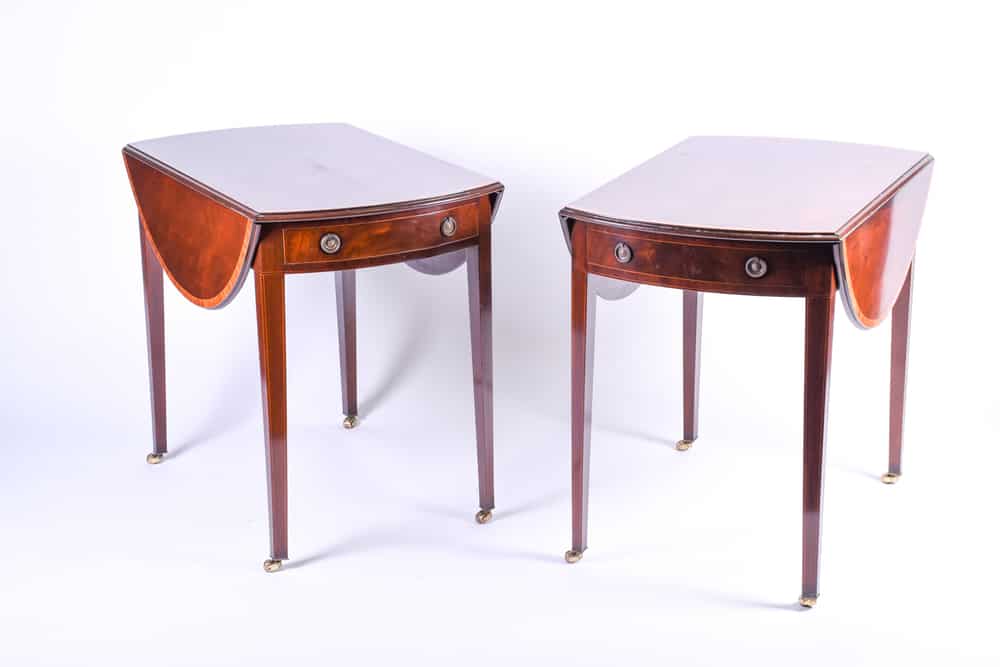
i have a antique drop leaf table on a beautiful pedastool it also has a drawer at one end in looking for serious antique dealers this table is over a hundred years old